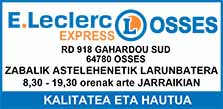Cole Peterson. “Sweet Promised Land” — written in 1957 by Robert Laxalt, a first-generation American of Basque parents — tells his father’s life story as an immigrant sheepherder in the American West of the early 1900s. I checked out a copy ahead of this past “Trailing of the Sheep” festival in Sun Valley after noticing a book discussion on the event schedule led by local author and rancher Diane Peavey, and it was the first event we attended at the festival.
Only a few minutes in, Diane stopped to ask the group, “It’s interesting isn’t it. Is this their (the Laxalt’s) story or is it our own?” The question was swept away largely unnoticed in the rising tide of impassioned dialogue, which in itself was answer enough. After that moment, the book was hardly referenced again directly; in the context of the conversation it served merely as a canvas for participants to paint the histories of their own families. Each speaker stood to offer up their contributions — an eye here, an elbow there — and the final product was a collective, vividly alive picture of the Basque immigrant experience and the characters who comprised it, broad and full of personality like Picasso’s “Guernica” (which depicts the 1937 bombing of the Basque cultural center Guernica during the Spanish Civil War and was brought up in the discussion).
The immigrant experience of Basque sheepherders in the late 1800s and early 1900s was a uniquely challenging one. Starting over in a new country severed from family and culture, Basque sheepherders had to do it alone in the most literal sense of the word. Once they arrived and joined a livestock outfit or purchased their own sheep, Basque boys and men fresh off their travels embarked solo into the foothills of the American West with their flocks, ranging sparse and unforgiving desert for weeks at a time without human contact and all the meanwhile at the financial mercy of an unpredictable livestock industry. When the men were gone in the hills, Basque wives were left behind in small towns to hold together families and raise children in a foreign land. Solitude and harsh landscapes shaped stoic and resilient men. Distanced families produced wildly resourceful women. As for the children and grandchildren that followed? I feel lucky to have experienced the gratitude, pride, reverence, and sense of community that I watched unfold in the short hour-and-a-half discussion.
Early in the conversation, speakers pondered the ages of their fathers and grandfathers when they first arrived in the U.S.: 14, 17, and another who celebrated his 16th birthday at Ellis Island were among those mentioned. One granddaughter tearfully described that despite his stoic and weathered demeanor, her grandfather “never stopped being that 16-year-old Basque boy with big hopes and dreams.” Another recalled his grandmother, and how throughout adulthood he’s often asked himself during hard times “what would Amuma do?”; a tribute to the woman’s strength and resolve.
Others told stories of relatives who, by mysterious strokes of luck, escaped death in war-torn Europe to later travel to America as the whole room listened in awe. One man stood to speak about the lives of his grandparents: “They suffered. They suffered for me, and I’m thankful.” Gratitude swelled through the room for lives and opportunities made possible by the brave individuals before them who took a generational-shifting risk and struggled to make it work. He still runs the operation his grandfather started a century ago in Northern Idaho, and of independent motive learned the Basque language while in college at Boise State to further connect with his roots — a decision that he later told me “changed his life”.
Each story rolled through the room in waves of enraptured silence, laughter, and nostalgia, and once again my girlfriend and I exchanged a knowing glance and a smile; doing our best “what the heck did we get ourselves into” faces as we fought back laughter and tears. There were animated imitations of relatives now passed and retellings of stories handed down through the generations. At one point, several members of the audience traced their lineage back to the same remote village in Basque country, exclaiming “we could be cousins!” Basque expressions were exchanged. Touched, non-Basque speakers came forward to tell their own family’s parallel immigration stories and others compared the sentiments of hope and perseverance of their Basque forefathers to the newest communities of immigrants across Idaho towns.
The legacy of Basque sheepherders lives on in Boise through a rich cultural presence and active Basque community, which numbering at 16,000 people is one of the largest in the entire country. “The Basque Block” located on Grove Street between North Capitol Blvd. and Sixth St., a quaint city strip adorned with both American and Basque Country flags in the heart of downtown, is the acting cultural center for Basques in the Treasure Valley. The street is home to several Basque-owned establishments as well as The Basque Museum and Cultural Center, a small and beautifully crafted space exhibiting Basque history both locally and abroad, as well as featuring notable contributions of Basques to the Idaho and national community through the years. An interactive exhibit in the heart of the museum simulates the sights, smells, and textures of a sheep camp typical to Basque herders of the past. Just a few blocks down the road, Boise State University offers a degree in Basque Studies.
A sentiment that was echoed both in the book discussion and on Basque block is the generational trend of Basque cultural affiliation — a progression common to many immigrant groups across America: The first generation, who struggled to assimilate into a new culture and faced the harsh realities of prejudice and discrimination, often pushed the second generation to Americanize and fit in, equipping themselves to take full advantage of opportunities unavailable to their parents. It is now the later generations — the third and the fourth — who crave a deeper connection to their ancestral roots and have initiated a resurgence of Basque culture and language in the area. It’s a movement to celebrate — one that enriches the Boise community and brings both our shared and individual origin stories to light.
The discussion, originally slotted for an hour, was cut off after an hour and 20 minutes, though if left uninterrupted could have persisted for hours more. Diane closed the event by sharing an essay of hers that she had previously read for local radio, relaying her long-standing love of “Sweet Promised Land,” and afterwards, lively conversation once again filled the room as attendees visited in smaller groups. Through the remainder of the weekend’s festivities, my girlfriend and I gravitated back towards groups and activities a bit more typical to a couple of 23 year olds; however, equipped with a newfound understanding and appreciation for the people and traditions around us, we had an experience of the trip that neither of us could have expected, but nonetheless were grateful to have.



 Enviar a un amigo
Enviar a un amigo Añadir comentario
Añadir comentario








